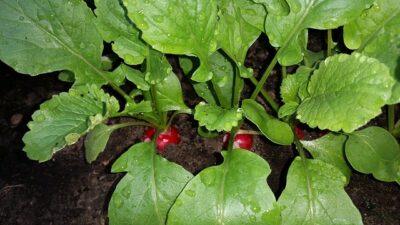Companion Planting: Vegetable “Buddies” That Actually Thrive Together is courtesy of Total Survival
Companion planting makes sense in an organic garden by creating plant diversity and using garden space more efficiently. Some plants work as pest deterrents, while others act as traps, drawing harmful bugs away from more susceptible veggies. Some gardeners are convinced that companion planting doubles the harvest, making it well worth the extra effort.
Companion planting can produce lots of benefits.
Companion Planting Goes Way Back
The Native American Three Sisters planting method, which involves corn, beans and squash, is one of the best examples of how companion planting works. As corn stalks gain height, they provide support for vining bean plants, and the beans repay the favor by fixing nitrogen in the soil. Squash, a fast-growing plant, does its part by shading the soil, preserving moisture and helping keep weeds in check.
Keep in mind that companion planting is not an exact science, and what works well for your friend across town may not work for you. Experimentation will reveal what natural friendships crop up in your garden.
Companion Planting Ideas For This Year’s Garden
Beets – Cabbage and related plants do well near beet plants, as do members of the onion family. Beets also like bush beans, lettuce and chard, but it’s best to keep them away from pole beans.
Beans – Bush beans interact positively with cucumbers, corn, radishes, celery, beets and members of the cabbage family. Pole beans, on the other hand, are a little pickier. They get along famously with radishes and corn, but hate beets. Plant potatoes next to either type of bean if you have problem with beetles, as potatoes tend to repel the pests. Avoid onions, garlic, leeks and chives, which may stunt bean plant growth.
Carrots – Onions, garlic and leeks help repel carrot flies and other pests, while members of the cabbage family also tend to discourage various pests that bug carrots. Beneficial carrot buddies also include peas, beans, lettuce, radishes, peppers and tomatoes.
Sweet corn – Beans are super helpful companion plants for corn, attracting beneficial insects that feast on corn-ravaging pests. Other companion plants that may enhance corn plant growth include potatoes, beans, melons, squash, pumpkins, cucumbers and peas. However, plant corn and tomatoes at least 4 feet apart, as the two don’t do well together.
Cucumbers – Cucumbers thrive on nitrogen that peas and beans provide to the soil, while radishes help by drawing cucumber beetles away from tender cukes. Corn is a good companion for cucumbers, but potatoes and melons aren’t so good. Plant them in a different area of the garden.
Lettuce – Plant onions, garlic and chives nearby to deter aphids, maggots and other pests. Additionally, you can plant lettuce under tall tomatoes or corn, as lettuce appreciates the cool shade. Lettuce also gets along well with carrots, cucumbers, parsnips, beets and members of the cabbage family.
Onions – Onions grow well alongside many vegetable plants, including tomatoes, beets, peppers, lettuce, carrots, chard and most members of the cabbage family (with the exception of kohlrabi).
Peas – Plant peas near radishes, carrots, corn, cucumbers, parsley, tomatoes and turnips, but not in close proximity to onions, garlic, leeks or chives.
Peppers – Peppers get along well with most vegetables, including eggplant, parsley, carrots, tomatoes and members of the onion family. On the other hand, beans and peppers aren’t a good combination.

Companion planting needs to be considered before the spade hits the dirt.
Radish – Radishes are cheerful little plants that get along with most vegetables, including carrots, beets, parsnips and spinach. Many gardeners think companion planting radishes and lettuce makes radishes more tender. However, it’s best not to plant radish in close proximity to members of the cabbage family.
Spinach – When you plant spinach and radishes side by side, the spinach works as a trap plant. This means that it attracts leafminers that are capable of decimating your spinach crop. Chinese mustard works in much the same fashion. Spinach also grows well alongside eggplants, celery and members of the cabbage family.
Potatoes – Plant spuds along with beans, eggplants, corn, peas and members of the cabbage family. Nevertheless, you should locate tomatoes, melons, squash, turnips and cucumbers in another corner of your garden.
Tomatoes – Many gardeners believe that chives can make tomatoes even sweeter. Other good tomato companions include parsley, carrots, celery, asparagus, onions, garlic and leeks. Tomatoes and corn are enemies, primarily because they tend to attract the same pests. Similarly, potatoes are susceptible to the same blight, which means they aren’t good companions for tomatoes. Plant tomatoes away from cauliflower, kale and other members of the cabbage family. They are believed to stunt tomato plant growth.
Which vegetables do you plant near one another – and avoid planting near one another? Share your tips in the section below:
Every Spring, Gardeners Make This Avoidable Mistake — But You Don’t Have To. Read More Here.
The post Companion Planting: Vegetable “Buddies” That Actually Thrive Together appeared first on Off The Grid News.
This Article Was Originally Posted On offthegridnews.com Read the Original Article hereCheck Out The Post Here: Companion Planting: Vegetable “Buddies” That Actually Thrive Together
No comments:
Post a Comment